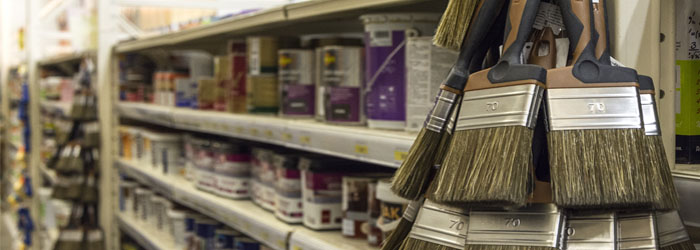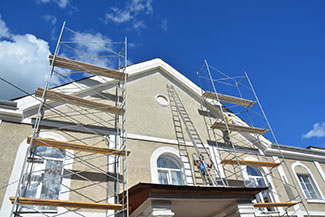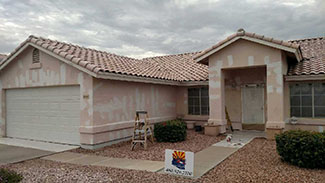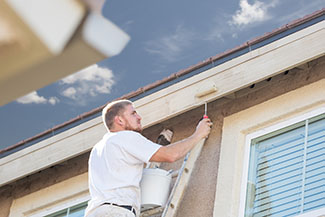How to Choose the Right Paint
 02 October 2018
02 October 2018 

Key Things You Need to Know About Paint for a Home's Exterior
If the outside of your house is looking shabby, you may be thinking about having it repainted. But like most homeowners you're wondering about what paint to use.
 After all, that very thin layer of paint – about the thickness of one sheet of 20-pound copier paper – is all that's out there protecting your house from Arizona's relentless sunshine and monsoon rainstorms. You want to choose the right paint and be sure it is applied correctly, but you also want to stay within an acceptable budget for paint, a commodity that always seems to cost more.
After all, that very thin layer of paint – about the thickness of one sheet of 20-pound copier paper – is all that's out there protecting your house from Arizona's relentless sunshine and monsoon rainstorms. You want to choose the right paint and be sure it is applied correctly, but you also want to stay within an acceptable budget for paint, a commodity that always seems to cost more.
So how do you choose exterior paint and how do you know if the quality is right for your home?
1 | Start by hiring a reputable contractor
Make sure you hire a licensed, bonded and insured contractor. According to some painting experts, that can easily weed out 60 percent of the painters in the marketplace. Too many painters with poor qualifications get into the business temporarily during tough economic times. So verify the licensing status of your potential contractors. You can check out more tips and our online recommendations about how to find the right person to paint your house by visiting: RosieOnTheHouse.com | Rosie's Painting Consumer Guide.
2 | The basic rule of exterior paint
 The basic rule for most exterior painting in Arizona is: Use good quality, 100 percent acrylic exterior paint on wood, masonry, stucco, metal, and vinyl. Just because it's labeled "100 percent acrylic" does not mean that it is also good quality paint, according to Don Brees, project manager with Rosie on the House Remodeling. So, specify the quality that you want as well when you hire someone.
The basic rule for most exterior painting in Arizona is: Use good quality, 100 percent acrylic exterior paint on wood, masonry, stucco, metal, and vinyl. Just because it's labeled "100 percent acrylic" does not mean that it is also good quality paint, according to Don Brees, project manager with Rosie on the House Remodeling. So, specify the quality that you want as well when you hire someone.
3 | Know the class of paint you want
All major paint manufacturers in the United States produce three classes of paint, Brees noted: low side production grade paint, midline good quality paint, and premium grade paint. Most use special names for the level of quality. For example, Dunn Edwards labels its mid-quality exterior paint as "Spartashield."

The easiest way to check those special names is to ask the contractor what paint they will use and then call the paint store to find out what the level of quality is for the specific name.
4 | Special paint designed for the Southwest
If you stick with one of the major paint brands, that brand will probably have a formula for its paint that is specific for use in the Southwest. It's been designed to handle the high heat and powerful UV rays of the desert. A paint salesman can tell you what ingredients were mixed into the paint to handle desert climate conditions. Remember that lighter colors will look better and last longer in the desert than darker colors. Premium paint will resist cracking, peeling and blistering and carry a manufacturer's warranty.
5 | Better quality paint means a better quality paint job
Using better quality paint is usually worth the extra cost because that paint will cover surfaces faster and more smoothly and also last longer. All of that can save you time and money in the long run. That brings us to the big question: How often do you have to repaint your house in Arizona? We generally say about seven years for masonry and stucco. But if your house is looking really shabby, you may have to repaint more often.

6 | Maintenance is key
Brees also says you can make the paint job last longer by doing proper maintenance on stucco and masonry once a year. That would include filling cracks and gaps in the surface of the house and repainting those areas. Otherwise, paint on those cracks will peel and lift off the surface.
Paint on a home with wood siding and wooden fascia boards along the roof will not last as long as a stucco paint job. Wood siding may need repainting after five or six years. Wood fascia probably needs to be repaired and painted again every year or so. Repainting fascia is a possible do-it-yourself job for homeowners who are skillful enough to work on ladders.
And remember, you'll be surprised and pleased by how wonderful your home will look once it's repainted.
###
Photo Credits:
RELATED CONTENT:
- Blog: What Signs Tell You It’s Time to Paint Your Home's Exterior?
- Blog: 10 Facts You Need To Know About Water Damage
- DIY FAQ: Rosie's Painting Consumer Guide
- DIY FAQ: How Do I properly Store Paint and Other DIY Materials?
- Podcast: 10 Facts You Need To Know About Water Damage
Print this page
recent post
- Duck, Duck, Duct! How Often Should Ductwork Be Cleaned?
- Vinyl vs. Fiberglass Windows: Which Is The Better Choice Of Replacement Window?
- We May Be The Grand Canyon State, But The Rocky Mountains Are Important For Arizona
- Welcome to Arizona! Things A Newbie to Arizona Should Know
- The Pros & Cons of Buying A Flipped House
- Getting In On The Ground Floor
- Why It’s More Critical Than Ever To Get Your AC Serviced Before Summer
- The Reality of Remodeling
- What To Look For When Comparing Your Roofing Quotes
- What To Expect When Buying New Windows & Doors
